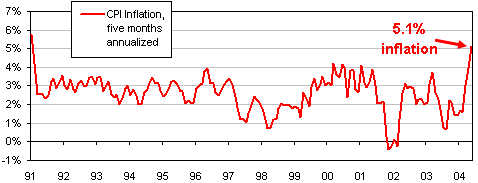The factor dominating the strategic situation is the long-overdue end to the Federal Reserve’s patience in maintaining low interest rates. The single most important matter now facing the market is the urgent need for the Fed to raise interest rates — now!
This week’s release of May consumer price index data was widely greeted by the market as being a sign that inflation isn’t as bad as hawks like me have been warning. But frankly, I simply don’t know how you can look at the data and not be terrified.

So far this year, inflation has been running at an annualized rate of 5.1%. That’s up from just 1.4% at year-end. The sudden surge sticks out on the chart below like a sore thumb — and it puts inflation back at a level we haven’t seen since 1991.
By the way, if you cheat and take out food and energy prices, inflation this year is “only” running at a 2.9% annualized rate. But that, too, is a surge — up from 0.9% at year-end. There’s just no denying it: The inflation monster is back. Now the only question is, How little or how much damage are we going to let it do before we stop it?
Yes, yes, I know. You don’t want the Fed to raise interest rates because that will “squelch the recovery” or “burst the housing bubble” or “hurt the consumer” and all the rest. Sorry, I don’t believe any of that. Sure, there are people who’ve gotten used to a couple of years of unusually low rates, and a few who will squawk when rates inevitably go up. But we’re in a strong recovery, and overall we’ll do just fine with more normal rates.
The real risk is letting inflation surge onward unchecked. Just in case you’ve forgotten the lessons learned so painfully in the 1970s and 1980s, let me remind you what inflation can do.
Obviously, when there’s inflation, prices go up. You pay more for almost everything. That’s bad, but it’s not the end of the world if your income inflates along with those prices. But it’s not that simple.
There are lots of people whose incomes won’t go up in an inflationary economy — such as retired people with money invested in bonds or annuities. There’s no other way to describe what inflation does to people like that except to say it destroys their wealth. That’s one of the main reasons I’ve been saying over and over that you absolutely must get out of bonds.
And there’s another class of people who get hurt by inflation, too — and you are probably a member of that class. I’m talking about people who invest in stocks.
Aren’t stocks supposed to be a hedge against inflation? Well, the historical record on that is mixed. Overall, stocks have done better in times of falling inflation than they have during times of rising inflation.
There are two key reasons for that. One is that investors prefer certainty about companies’ future earnings, and inflation makes everything less certain. But there’s another reason, too, and this one strikes very close to home: I’m talking about taxes.
Walk through an example with me. There’s a little bit of arithmetic here, but try to follow along.
Suppose you buy a stock today at $10 a share, and hold it for ten years. If it grows 10% a year, then thanks to the magic of compounding, it will be worth $25.94 in 10 years — so you can sell it for a profit of $15.94. At today’s federal capital-gains tax rate of 15%, you’ll pay taxes of $2.39, for a net after-tax profit of $13.54.
But (and there’s always a “but” when it comes to taxes) that assumes there is no inflation. Now let’s suppose that over the 10 years there was inflation at today’s present annual rate of 5.1%. Just to keep up with inflation, your initial $10 investment would have to grow to $16.44. So when you sell your stock at $25.94, your real profit after inflation is actually only $9.49, not $15.94.
The rub is that you’ll have to pay the same capital-gains taxes of $2.39 based on the whole reported profit of $15.94, even though your real profit after inflation is only $9.49. That’s because the capital-gains tax is not indexed against inflation the way ordinary income taxes are. That means you are paying an effective capital-gains tax of 25.2%, not 15%.
So after inflation and after taxes, your net profit is only $7.10, not $13.54. Isn’t it clear that stocks will have to trade at lower prices today when investors have to wonder whether their profit will be $7.10 or $3.54?
But it can be worse than that. Work through the numbers for cases where the stock didn’t perform so well. You’ll see that, thanks to inflation, it’s easily possible to show an after-inflation, after-tax loss on an investment that appears at first to be profitable. That was actually a fairly typical problem during the 1970s when stock returns were lower and inflation was higher.
I’m convinced that a big part of the market’s malaise this year has been the result of investors wondering just how bad their capital-gains tax rate is going to be in the future. It has been bad enough that the cut in the capital-gains tax rate enacted last year — reducing the top rate from 20% to 15% — would be repealed if John Kerry were elected (he has said many times he wants to reverse some of Bush’s tax cuts).
But on top of that risk, we’ve got a Federal Reserve that might raise capital-gains taxes no matter who is elected president — by failing to raise interest rates aggressively and promptly, and thus put a lid on inflation.
The following is an “Ahead of the Curve” column published June 18, 2004 on SmartMoney.com, where Luskin is a Contributing Editor.









